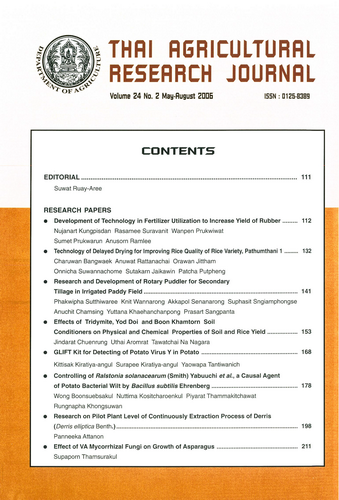Controlling of Ralstonia solanacearum (Smith) Yabuuchi et al., a Causal Agent of Potato Bacterial Wilt by Bacillus subtilis Ehrenberg
DOI:
https://doi.org/10.14456/thaidoa-agres.2006.14Keywords:
antagonistic bacteria, Bacillus sp.. bio-control agent, soil-gorne diseaseAbstract
Collection of the potential antagonistic bacteria against Ralstonia solanacearum (Rs) casual bacterial with disease from soil, and root (rhizoplanes) were made from eighteen provinces. The samples of the former material were taken form non disease plant in disease severity infection of several crops area namely potato, tomato pepper, eggplant and ginger. Three hundred nineteen bacterias were isolated by general King-B medium and had been screening for growth inhibition property against R. solanacearum by direct bioassay method. Using disc diffusion method tested to search the antagonistic bacteria form the potential antagonistic bacteria culture suspension and its culture filtrate with double layer culture of R. solanacearum on PSA (Wakimoto’s potato semi synthetic agar) 1.5 and 0.5% agar. The results showed that fifteen isolates antagonized on R. solanacearum, inhibited with strongly clear zone 4-20.75 mm by its culture and 6.25-25.00 mm by culture filtrated. The five higher clear zones were tested for biocontrol microorganism agent for this disease on young tomato plant under green house condition. The results were found that five isolates could pre-diseased control the bacterial with disease of tomato in green house condition at range 23.4 – 80% but could not control on post diseased condition. These 5 antagonists were effective in field condition and the striking outcomes were obtained at Tak Horticulture Research Station in the northern of Thailand on which the field had been heavily infected during 2003 – 2004. In this biological control, the potato was dressed with the suspension of the antagonists at the concentration of 10<sup>9</sup> cfu/ml before planting and drenched (10<sup>6</sup> cfu/ml) every 7 days for four times. The result showed that these antagonists controlled significantly the bacterial wilt disease at 15.8 – 44.9%. The same trials were also conducted at bigger areas (farm trial) in 2 locations at Chaing Mai and Kanchanaburi provinces during 2004-2005. The result showed that these antagonists are strikingly effective control at 66.6 – 85.6% of this notorious wilt disease. Furthermore, the treatment with the antagonists promoted well the potato yields in non-disease condition trial higher than control treatment. A novel method which was invented for rapid identification of bacteria by using TLC with amino lipids was successfully applied for the identification of these antagonistic bacteria. The 5 antagonists were identified as Bacillus subtilis which the common spot at Rf. 0.36 existed on their TLC chromatogram. DOA.WB4 was shown higher performance of biocontrol agent for potato bacterial with than others.
Downloads
Published
How to Cite
Issue
Section
License
Copyright (c) 2006 Thai Agricultural Research Journal

This work is licensed under a Creative Commons Attribution-NonCommercial-NoDerivatives 4.0 International License.
Thai Agricultural Research Journal



